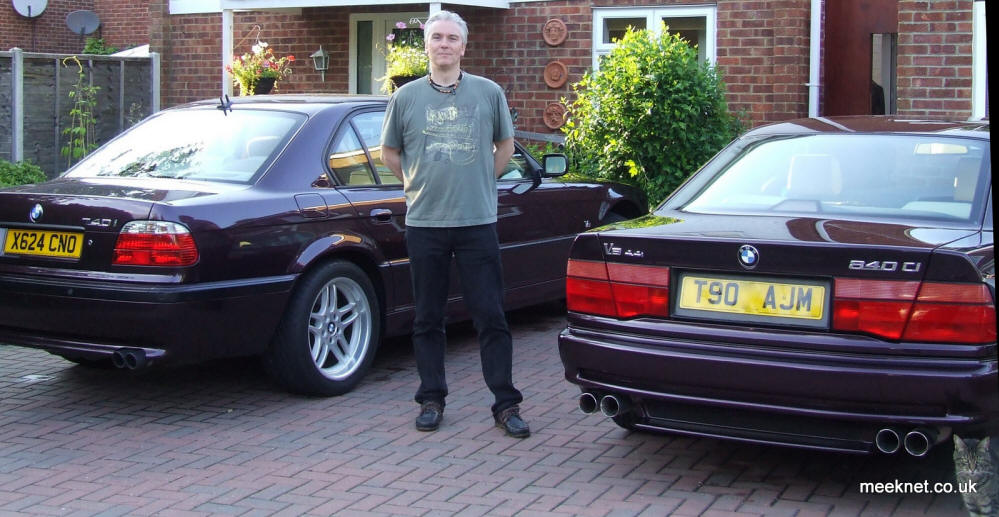TIMM'S 7-SERIES
REPAIRS AND
INFORMATION
The 7-Series BMW's are brilliant cars,
and in 2009 with the
present economic climate, very cheap and very unfashionable! For a very small
outlay you can own a car that initially sold for anywhere between £40,000 and
£90,000 depending on what options were fitted. You also get the very finest
engineering that was available with options that are only now becoming common on
new cars. The 7-Series is not only a luxurious car it is also a high-performance
car that handles better than many sports cars.
Although the E32 and the E38 both weigh around 2 Tons they can still take
corners at speeds that see other cars going straight on. The V8 and V12 models,
especially the 740i (V8) and 750i (V12) are very quick off the mark with 0-60MPH
times just over 6 seconds and electronically-limited top speeds of 155MPH. The
E32 750i's with 300BHP really are wolves in sheep's clothing with 'luxury
barge' looks (when on standard wheels) but with acceleration at motorway speeds
that embarrass modern cars.
My personal preference is for the V8 models, the first of which was introduced
in 1992 in the 730i and 740i. These were not cast-iron 'American' V8's though,
the BMW M60 was a lightweight all-alloy V8 which sported 32 valves, 4 overhead
camshafts, 8 individual ignition coils and sequential fuel-injection. The 740i
developed 286 BHP and 400 NM of torque which was coupled to an adaptive 5-speed
automatic gearbox.

A 1993 E32 730i - The V8 models
sported a wider kidney grille and wider bonnet volute
This and later E32 models have 'smiley face' dipped-beam units, earlier models
had a solid reflector
The E38 7-Series was introduced in 1994 with the V8 models retaining the E32's M60 engine (3.0Ltr and 4.0Ltr) although there are some subtle differences to the engine. In 1996 the first M62-engined models were released with an increase in capacity to 3.5Ltr (735i) and 4.4Ltr (740i). These cars were seen as more reliable due to the 'Nikasil problem' which put off some buyers of the M60-engined models.
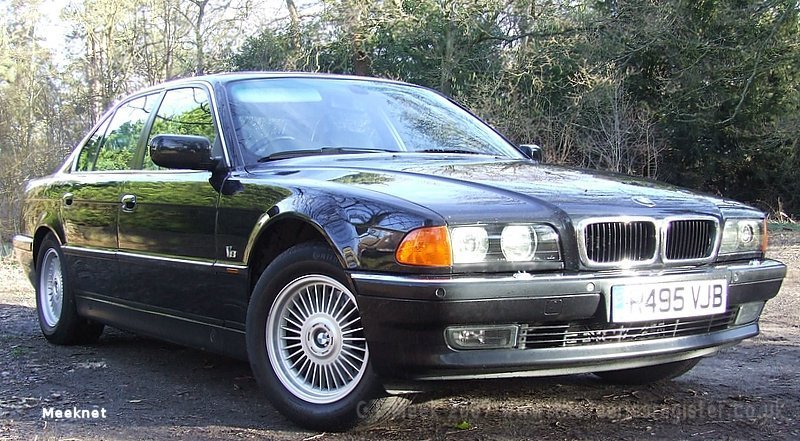
A pre-facelift 1998 735i V8 - The
headlights have a straight lower-edge
Unless specifically ordered the skirts are matt-black, no problem with a black
car!

The M62B35 3.5Ltr V8 engine
(pre-Vanos) - Three cables for throttle, cruise-control and ASC
Later versions of the M62 V8 which were introduced in September 1998 sported
twin-Vanos on the inlet cams. The 'Vanos' V8's retain the 286 BHP of the older
M60 even though
the capacity was increased to 4.4 Litres but the power-curve is flatter and the
available torque increased to 440 NM. This makes the Vanos-equipped 740i
exceptionally quick and more tractable, especially at low RPM.
The Vanos (variable valve timing) system was introduced to smooth the idle (which was always a bit lumpy) and to reduce emissions when cruising. At idle and when cruising the inlet valve timing is retarded to a point where the piston is descending before the valve opens, this increases the velocity and turbulence of the charge which allows a cleaner burn. The side effect of this is to increase the torque at low RPM. At wider throttle settings the inlet valve timing is advanced to maximise the charge induction. The M52 engine used in the 728i has double-Vanos, both the inlet and exhaust valve timing can be adjusted.
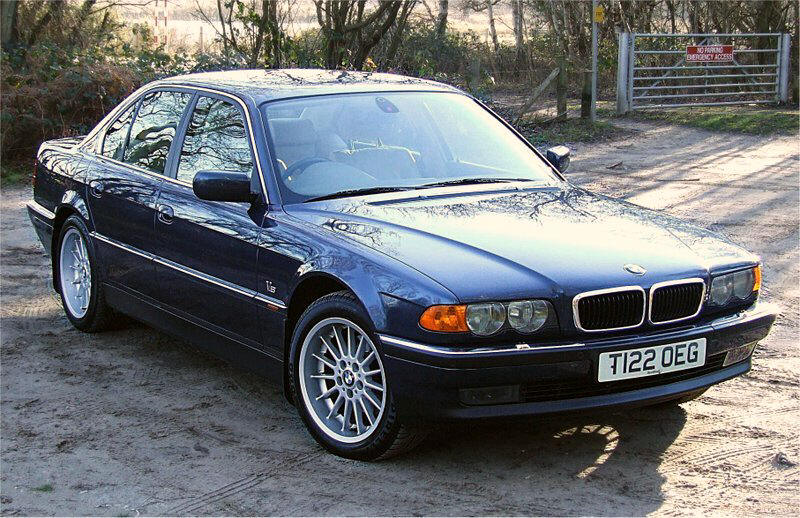
A 1999 post-facelift 740i V8 -
Scalloped headlights and 18" multi-spoke alloys - retains the black skirts
The indicators are amber front and rear although the rears are now glass instead
of plastic
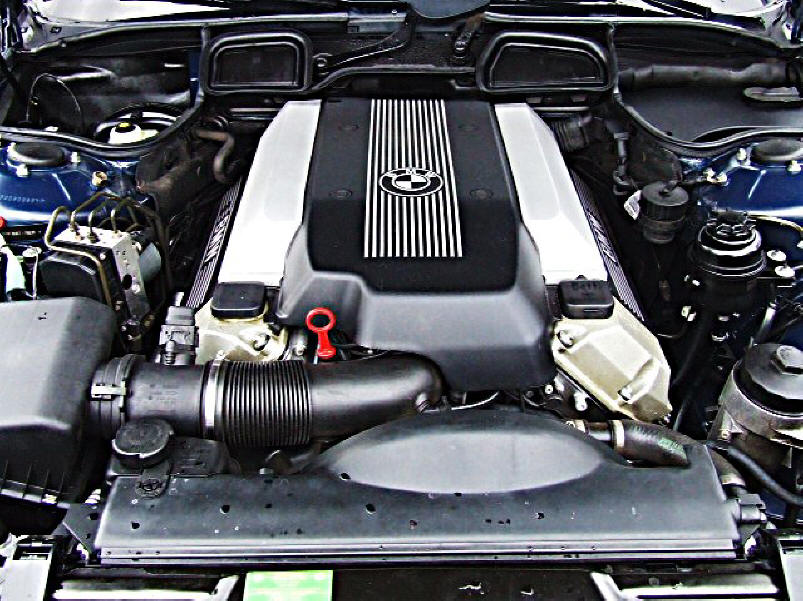
The M62TUB44 4.4 Ltr V8 engine with
Vanos - Uses electronic throttle body 'Fly By Wire'
No need for Idle-Control-Valve, ASC or Cruise-Control cables, all controlled via
electronic throttle
Around the same time, the 'Facelift' models were introduced with the first changes being made in September '98. These cars retain a higher resale value with the updated lighting and inclusion of other additions that were previously options. However, these changes were made piece-meal and there are various stages to the Facelift process. Fortunately, one of the first changes was to get rid of the awful plastic rear lights which suffered from condensation at best, and often filled up with water. The '99 rear lights were updated with glass 'crystal' lenses but still retained the amber indicators, late '00 models had clear indicators. To make things even more complicated certain models never received the full Facelift package as standard. For instance, even the final production of the 728i did not receive body-coloured skirts as standard.
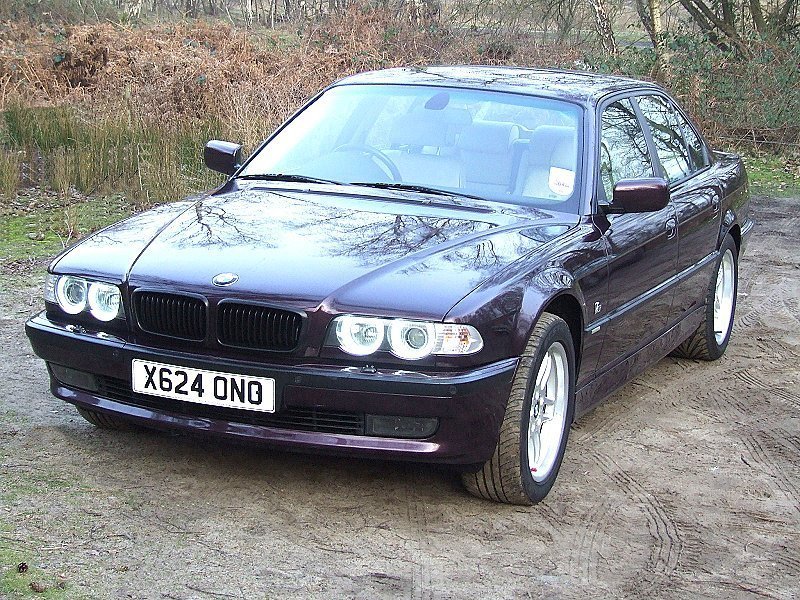
A 2000 740i V8 - Body-coloured skirts
for all but the 728i model - Black-grille not standard
Sport models were supplied with M-parallel alloys and shadowline exterior
This site is for anyone that owns either an E32 or E38 BMW 7-Series and wants to
repair the car themselves. The information on this site is either from my own
repairs (BLUE buttons) or from information I have found whilst investigating
problems (GREEN buttons). The SILVER buttons are for information on the cars
systems, owner's manuals and circuit diagrams. I am the current owner of a
1999 840ci Sport Individual and an ex-owner of a
2000 740i E38 Individual
a 1997 840ci
Sport, a '93 E32 730i
V8, a '98 E38 735i V8 and a '99
E38 740i.
I am an Administrator (Timm) on
The 7 Series
Register which (in my opinion) is the best Forum for 7-Series cars from the
E23 to the E65. All these fixes and information can be found on the Forum plus a
great deal more by experts in all versions of this great series. My initial help came from this Forum and this gave me enough
confidence to perform other repairs.
The 7 Series
Register is free to join, there is no need to register
but please do and you will find a world of
friendly 7-Series owners ready to help you! Some of the repairs are pretty
straightforward, some are pretty awkward but none of them are that difficult.
Just like most of The 7 Series Register members I am not a mechanic and consider
myself a rank amateur. However I am lucky to have the experience of our members
and my own experience of my four 7-Series cars, the greatest asset we all share
is knowledge of what normally goes wrong and how to fix the problems!
It is worth mentioning that the cars worked on are UK (right-hand drive) models. There are a few differences between RHD and LHD variants, specifically, changing the Microfilter on E32 models is one of the few jobs that has major differences. Indispensable sources of information are the WDS circuit diagrams for the E38, the TIS (Technical Information System) and the ETK (electronics part catalogue). All three are usually available from Ebay for a few quid. There is only one simple circuit diagram for the E38 (for the 1995 model only) which can be found on this website, the electronics became too complicated to be represented on a single-level diagram pretty quickly and the WDS soon became the only method to trawl through all the circuits. The brilliant RealOem website is excellent for finding the correct part numbers and for exploded diagrams.
I am also a musician, so click on the 'Chase' tab and download some music while you peruse the information!
